Use of weapons


Gun use is the use of weapons by people.
All weapons in the sense of objects come into consideration here: cutting and stabbing weapons , firearms , cannons , explosives and much more. The use of weapons is, except in practice , always an use of force . Except when hunting , it aims to weaken combat readiness.
Types of weapon use
exercise
Weapons can be used for exercise. The handling of the weapon and the possibilities of its use can be trained here. In many cases, training weapons are used for cutting and stabbing weapons, which reduce the risk of injury. When it comes to firearms , training is often carried out with practice ammunition (e.g. blank cartridges).
In exercises with real ammunition, at the end of an exercise in the military, the command is given to “restore safety”, which causes the firing to stop and the bolt to be secured (“S”). This is to prevent physical damage (in extreme cases, death) to people in the field of fire.
Sports
In sport, the use of weapons serves to achieve a sporting goal. These include B. a maximum throwing distance or precise shooting , z. B. in the sport of biathlon .
offensive
The offensive use of weapons is aimed at attacks, arrests or threats.
- Attacks : Assault , Access (Police, Customs) Aggression ( Military )
- Halts (police, judiciary, customs, etc.): for fugitives, e. B. Prison Break
- The use of weapons can also serve as a threat . By holding a weapon or z. B. a warning shot , the opposite person is to be forced to act or omit. In crime, threatening is a criminal offense (e.g. bank robbery or extortion ). The illegal use of weapons is the misuse of weapons, often adding to this the illegal possession of weapons and other offenses.
defensive
The use of weapons can also serve defense, i.e. thwart or prevent an attack (especially self-defense , crime , self-defense , self-help ) and, in the military, defensive war .
hunt
The use of weapons in hunting on wildlife is very common. A ranged weapon is always used in hunting today; in Europe mainly firearms (rifles) whereas in the USA and Canada traditional hunting with a bow and arrow or a spear is still widespread. It is used to kill game or protect hunting .
Others
Gun use occurs in some other situations as well, e.g. B. in averting danger (including suicide attempts ) and duels / fencing .
consequences
Consequences of using a weapon can result in death or injury , e.g. B. with the aim of stopping or reducing the ability to attack. The consequences of gunshot wounds are examined in the field of wound ballistics . Under certain circumstances the user of a weapon (marksman) can injure himself.
Choice of weapon
When choosing from several weapons, these options are conceivable: You can choose primary weapon or secondary weapons . You can choose close or ranged weapons. Another possibility is the selection according to the effect: lethal and non-lethal weapons .
user
A legal specialty is the use of weapons by officials in the competent and lawful exercise of an act of sovereignty ( state authority ). The provisions on direct coercion apply here , e.g. B. the use of weapons by the police or the military guard service .
Miscellaneous
The hand with which a weapon is held is called the hand holding a weapon . In the case of the opponent , disarming (of people) may lead to “victory”, at least to a weakening of his ability to attack.
Firearms are referred to as the use of firearms . Certain weapons customs governs especially in civilian life weapons law . The shooting is the wandering of a projectile , yet not there must be a firearm act (z. B. arrows).
The use of weapons at close range replaces or supplements close combat , that is, the use of purely physical violence.
A small hit area or cover ( structural or laying down / kneeling) serves as protection .
Correct weapon handling is a prerequisite for effective, safe (and possibly rapid) use of weapons.

